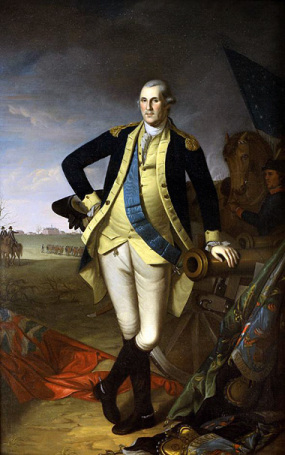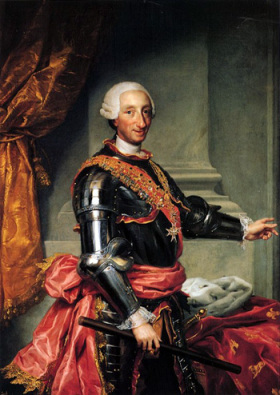By Stephen Brookes • The Washington Post • January 3, 2008
___________________________________________________________________________________

George Washington by Charles Willson Peale It's the celestial glow around George Washington that first grabs you; the sort of adoring, direct-from-heaven spotlight that painters reserve for Men of Destiny.
Leaning casually on a cannon, Washington looks supremely confident; storm clouds are giving way to blue skies overhead, and the flags of his enemies lie in the mud at his feet. Victory at the Battle of Princeton has brought the American struggle for independence to a turning point, and every inch of the canvas seems to radiate optimism. It's a portrayal, you can't help thinking, not just of Washington but of the new American republic.
And significantly, "George Washington at the Battle of Princeton" was originally sent to Spain, as a diplomatic gesture of thanks. It was painted by Charles Willson Peale in 1779, the year that the Spanish king, Carlos III, had joined France in declaring war on Britain -- a move of enormous help to the Americans. But the gift also reflected the far more extensive, and even crucial, role that Spain had been playing in the birth of the United States for years.
That little-known relationship is the subject of a thought-provoking exhibit at the National Portrait Gallery titled "Legacy: Spain and the United States in the Age of Independence, 1763-1848." Spanning a period from the Treaty of Paris to Mexico's ceding of California, it's a collection of some 70 portraits, maps and treaties that attempt to shed some light on this still-shadowy corner of history.
And, while it's not always an easy exhibit to decipher, it's worth the effort. France, of course, was America's key partner in the fight for independence from Britain. But the exhibit makes clear that, without the critical help of Spain in everything from financial aid to military action, the War of Independence might have taken a different course. And much of the credit goes to the remarkable Spanish personalities of the day, from the influential Count of Aranda (a tireless champion of the American cause) to Jorge Ferragut (who led campaigns against the British in North Carolina) and Bernardo de Galvez, who tied up the British navy at Pensacola in 1781, making it easier for Washington to seize victory at Yorktown.
Carlos III, by Anton Raphael Mengs"The mission of the Portrait Gallery is not only to collect images of the people who made a difference in American history, but to tell aspects of that history," says Carolyn Kinder Carr, the deputy director of the National Portrait Gallery and co-curator of the exhibit. "We've laid out the show to have a dialogue between the people who interacted. The portraits, in some ways, are entry points into history."
The events that unfolded from 1763 onward involved a range of characters, from kings and diplomats to explorers, writers and religious and military leaders, and the exhibit includes telling portraits of many of them. At center stage for much of the period was King Carlos III, and it's his striking portrait (on loan from the Prado museum in Madrid) that opens the show. Painted in 1761 by Anton Raphael Mengs, it shows Carlos in full military regalia with all the trappings of power around him. But Carlos himself is smiling, and he seems anything but imperious; it's the portrait of a man open to ideas -- the embodiment of an era of reform and enlightenment.
On a purely artistic level, it's a hugely impressive collection as well, including five portraits by Francisco de Goya, four by Charles Willson Peale, six by Gilbert Stuart, and more by John Trumbull, Vicente Lopez, Thomas Sully and other more obscure artists. The Goyas alone, in fact, make the exhibit worthwhile.
Other standouts include the portrait of Benjamin Franklin (who, as Commissioner to Spain, persuaded Carlos III to send money, uniforms and equipment to the American cause) by Joseph Siffred Duplessis, and a fine 1834 painting of Davy Crockett (killed at the Alamo, in the fight for the independence of Texas) by Chester Harding.
Pulling all of these figures into a narrative spanning 85 years, two continents and the birth of a nation is an ambitious task by any standard, and the exhibit is often as frustrating as it is enlightening; casual visitors may find themselves quickly at sea. But the exhibit is still well worth viewing. Not only is the portraiture almost always superb, but the paintings also make up a vivid reminder of Spain's profound impact on American culture -- and even on the birth of the country itself.
Legacy: Spain and the United States in the Age of Independence, 1763-1848, continues through Feb. 10 at the National Portrait Gallery, Eighth and F streets NW.